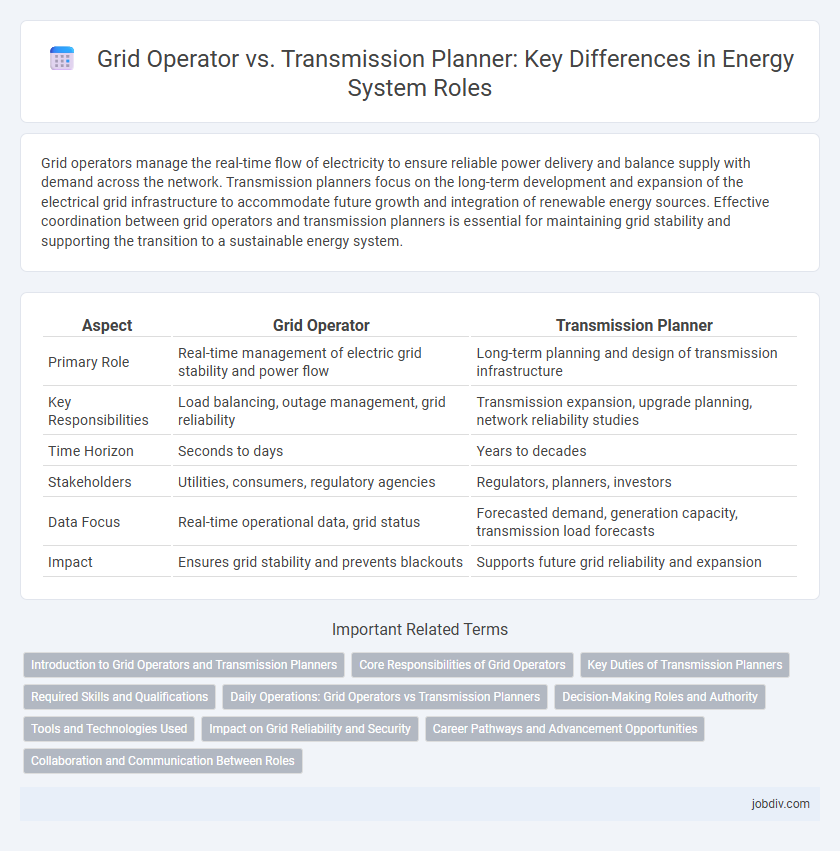Grid operators manage the real-time flow of electricity to ensure reliable power delivery and balance supply with demand across the network. Transmission planners focus on the long-term development and expansion of the electrical grid infrastructure to accommodate future growth and integration of renewable energy sources. Effective coordination between grid operators and transmission planners is essential for maintaining grid stability and supporting the transition to a sustainable energy system.
Table of Comparison
| Aspect | Grid Operator | Transmission Planner |
|---|---|---|
| Primary Role | Real-time management of electric grid stability and power flow | Long-term planning and design of transmission infrastructure |
| Key Responsibilities | Load balancing, outage management, grid reliability | Transmission expansion, upgrade planning, network reliability studies |
| Time Horizon | Seconds to days | Years to decades |
| Stakeholders | Utilities, consumers, regulatory agencies | Regulators, planners, investors |
| Data Focus | Real-time operational data, grid status | Forecasted demand, generation capacity, transmission load forecasts |
| Impact | Ensures grid stability and prevents blackouts | Supports future grid reliability and expansion |
Introduction to Grid Operators and Transmission Planners
Grid operators manage the real-time flow of electricity across power networks, ensuring system reliability and balancing supply with demand. Transmission planners focus on the long-term development and expansion of transmission infrastructure to accommodate future energy needs and integration of renewable resources. Both roles are crucial for maintaining a stable and efficient electrical grid.
Core Responsibilities of Grid Operators
Grid Operators manage real-time electricity flows across the power grid, ensuring stability and reliability by balancing demand and supply instantaneously. They monitor frequency, voltage, and system contingencies to prevent blackouts and coordinate emergency responses during disturbances. Their core responsibilities include dispatching generation resources, maintaining grid security, and facilitating market operations within the transmission network.
Key Duties of Transmission Planners
Transmission planners analyze grid capacity and forecast future energy demands to ensure reliable electricity delivery. They design transmission system expansions and upgrades to accommodate renewable integration and prevent congestion. Collaboration with grid operators optimizes system performance and maintains grid stability across regions.
Required Skills and Qualifications
Grid Operators require strong real-time decision-making skills, proficiency in SCADA systems, and a deep understanding of power system operations to maintain grid stability and respond to emergencies. Transmission Planners need advanced analytical abilities, expertise in power flow modeling software like PSS/E or PowerWorld, and qualifications in electrical engineering to design and optimize transmission networks for future demand. Both roles demand thorough knowledge of electrical codes, standards, and regulatory compliance within the energy sector.
Daily Operations: Grid Operators vs Transmission Planners
Grid Operators manage real-time system reliability by monitoring and controlling electricity flows across the network, ensuring immediate response to demand fluctuations and outages. Transmission Planners focus on long-term infrastructure development, analyzing load forecasts and system constraints to design upgrades that maintain grid stability over time. Both roles are essential for balancing operational efficiency and future capacity in the energy transmission sector.
Decision-Making Roles and Authority
Grid operators manage real-time electricity flow, ensuring system reliability and balancing supply with demand. Transmission planners develop long-term infrastructure strategies, evaluating capacity needs and system upgrades to accommodate future growth or policy changes. Decision-making authority rests with grid operators for operational adjustments and with transmission planners for investment and expansion planning.
Tools and Technologies Used
Grid operators utilize real-time monitoring systems, SCADA (Supervisory Control and Data Acquisition), and advanced analytics platforms to manage and control electricity flow, ensuring grid stability and reliability. Transmission planners rely on power flow modeling software, Geographic Information Systems (GIS), and long-term forecasting tools to design and optimize transmission networks for future demand and renewable integration. Both roles increasingly incorporate AI-driven predictive maintenance and digital twin technologies to enhance efficiency and resilience in grid management.
Impact on Grid Reliability and Security
Grid operators focus on real-time monitoring and control of the electricity network to maintain grid reliability and security by balancing supply and demand and responding to disturbances. Transmission planners analyze long-term infrastructure needs and develop strategies for grid expansion and upgrades to prevent congestion and ensure capacity adequacy. Effective coordination between grid operators and transmission planners is essential to mitigate risks of outages and enhance system resilience.
Career Pathways and Advancement Opportunities
Grid operators focus on real-time management of electricity flow, requiring strong skills in system monitoring and emergency response, while transmission planners develop long-term infrastructure strategies, emphasizing project management and regulatory knowledge. Career pathways for grid operators often lead to senior control center roles or operations management, whereas transmission planners may advance into specialized engineering leadership or policy advisory positions. Advancement opportunities in both fields demand continuous technical education and certification in power systems and energy regulations.
Collaboration and Communication Between Roles
Grid operators and transmission planners collaborate closely to ensure the reliability and efficiency of the energy system by sharing real-time data and forecasts essential for grid stability and expansion planning. Effective communication between these roles facilitates coordinated responses to operational challenges, system constraints, and future infrastructure needs. This collaboration optimizes resource allocation and supports the integration of renewable energy sources into the transmission network.
Grid Operator vs Transmission Planner Infographic

 jobdiv.com
jobdiv.com